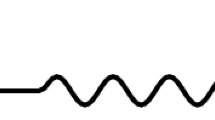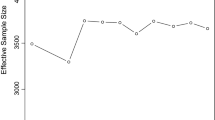Abstract
For a continuous-time Markov process, commonly, only discrete-time observations are available. We analyze multiple observations of a homogeneous Markov jump process with an absorbing state. We establish consistency of the maximum likelihood estimator, as the number of Markov processes increases. To accomplish uniform convergence in the continuous mapping theorem, we use the continuity of the transition probability in the parameters, the compactness of the parameter space and the boundedness of probabilities. We allow for a stochastic time-grid of observation points with different intensities for each observation process. Furthermore, we account for right censoring. The estimate is obtained via the EM algorithm with an E-step given in closed form. In our empirical application of credit rating histories, we fit the model of Weißbach and Mollenhauer (J Korean Stat Soc 40:469–485, 2011) and find marked differences, compared to the continuous-time analysis.




Similar content being viewed by others
Notes
Discussion at the Sixth Autumn Symposium of the Research Training Group “Statistical Modelling”, November 20th and 21st, 2009, Bommerholz, Germany.
References
Aït-Sahalia Y (2002) Maximum likelihood estimation of discretely sampled diffusions: a closed-form approximation approach. Econometrica 70:223–262
Aït-Sahalia Y, Jacod J (2009) Testing for jumps in a discretely observed process. Ann Stat 37:184–222
Amann H (1997) Gewöhnliche Differentialgleichungen. Springer, New York
Billingsley P (1961) Statistical inference for Markov processes. The University of Chicago Press, Chicago
Bladt M, Sørensen M (2005) Statistical inference for discretely observed Markov jump processes. J R Stat Soc Ser B 67:395–410
Bladt M, Sørensen M (2009) Efficient estimation of transition rates between credit ratings from observations at discrete time points. Quant Finance 9:147–160
Dehay D, Yao JF (2007) On likelihood estimation for discretely observed Markov jump processes. Aust NZ J Stat 49:93–107
Dempster A, Laird N, Rubin D (1977) Maximum likelihood from incomplete data via the EM algorithm. J R Stat Soc Ser B 39:1–38
Guttorp P (1995) Stochastic modeling of scientific data. Chapman & Hall, Suffolk, Great Britain
Jarrow R, Lando D, Turnbull S (1997) A Markov model for the term structure of credit risk spreads. Rev Financial Stud 10:481–523
Kim Y-D, James L, Weißbach R (2012) Bayesian analysis of multi-state event history data: beta-Dirichlet process prior. Biometrika 99:127–140
Keiding N (1974) Estimation in the birth process. Biometrika 61:71–80
Keiding N (1975) Maximum likelihood estimation in the birth-and-death process. Ann Stat 3:363–372
Hobolth A, Jensen JL (2005) Statistical inference in evolutionary models of DNA sequances via the EM algorithm. Stat Appl Genet Mol Biol 4:18
Koopman S, Lucas A, Schwaab B (2011) Modeling frailty-correlated defaults using many macroeconomic covariates. J Econom 162:312–325
Küchler U, Sørensen M (1997) Exponential families of stochastic processes. Springer, New York
Liese F, Miescke KJ (2008) Statistical decision theory: estimation, testing, and selection. Springer, New York
Mählmann T (2006) Estimation of rating class transition probabilities with incomplete data. J Banking Finance 30:3235–3256
Rosenow B, Weißbach R (2010) Modelling correlations in credit portfolio risk. J Risk Manag Financial Inst 3:16–30
van der Vaart A, Wellner J (1996) Weak convergence and empirical processes—with applications to statistics. Springer, New York
Weißbach R, Mollenhauer T (2011) Modelling rating transitions. J Korean Stat Soc 40:469–485
Weißbach R, Walter R (2010) A likelihood ratio test for stationarity of rating transitions. J Econom 155: 188–194
Acknowledgments
We would like to thank Friedrich Liese for his valuable suggestions. The financial support from the Deutsche Forschungsgemeinschaft is also gratefully acknowledged (Grant WE3573/2). All computations have been processed in MATLAB.
Author information
Authors and Affiliations
Corresponding author
Rights and permissions
About this article
Cite this article
Kremer, A., Weißbach, R. Consistent estimation for discretely observed Markov jump processes with an absorbing state. Stat Papers 54, 993–1007 (2013). https://doi.org/10.1007/s00362-013-0515-0
Received:
Revised:
Published:
Issue Date:
DOI: https://doi.org/10.1007/s00362-013-0515-0




